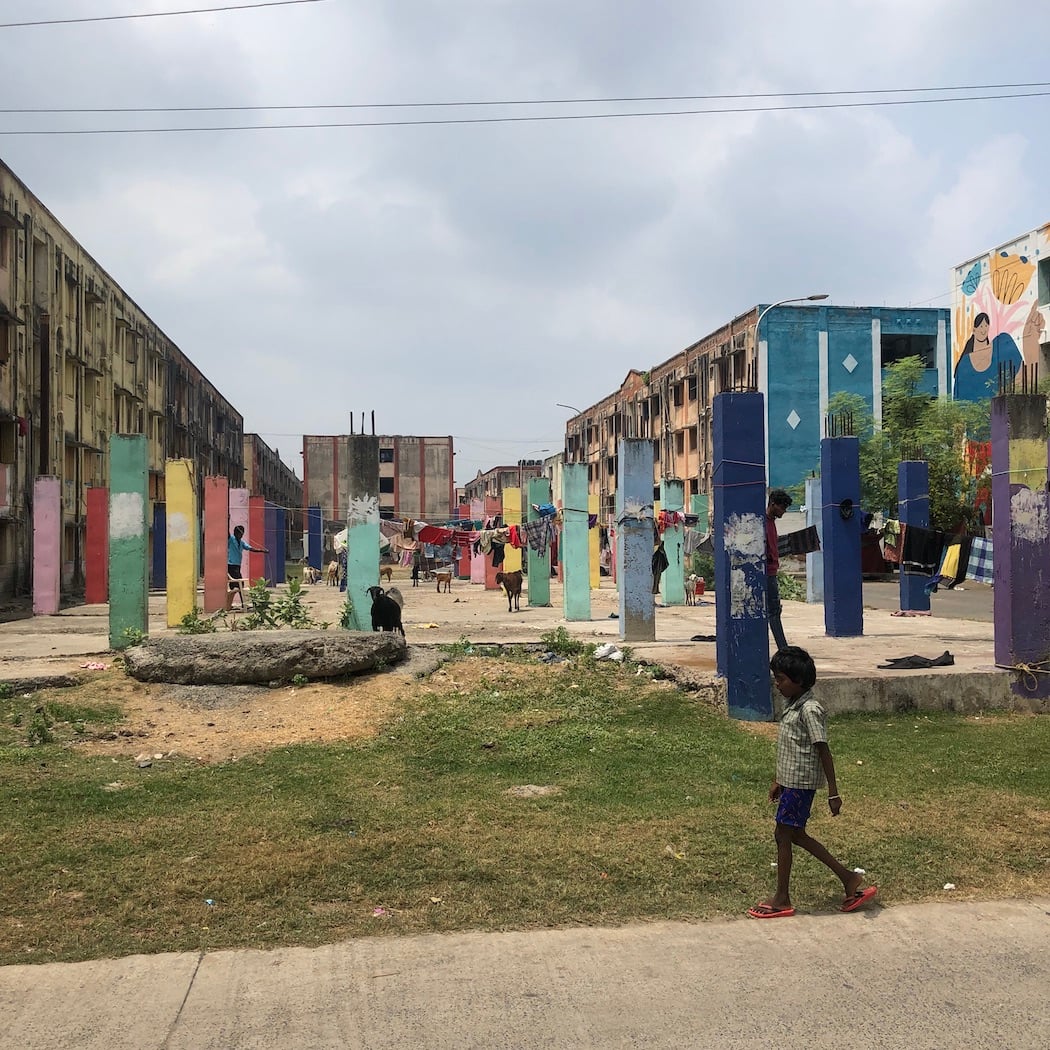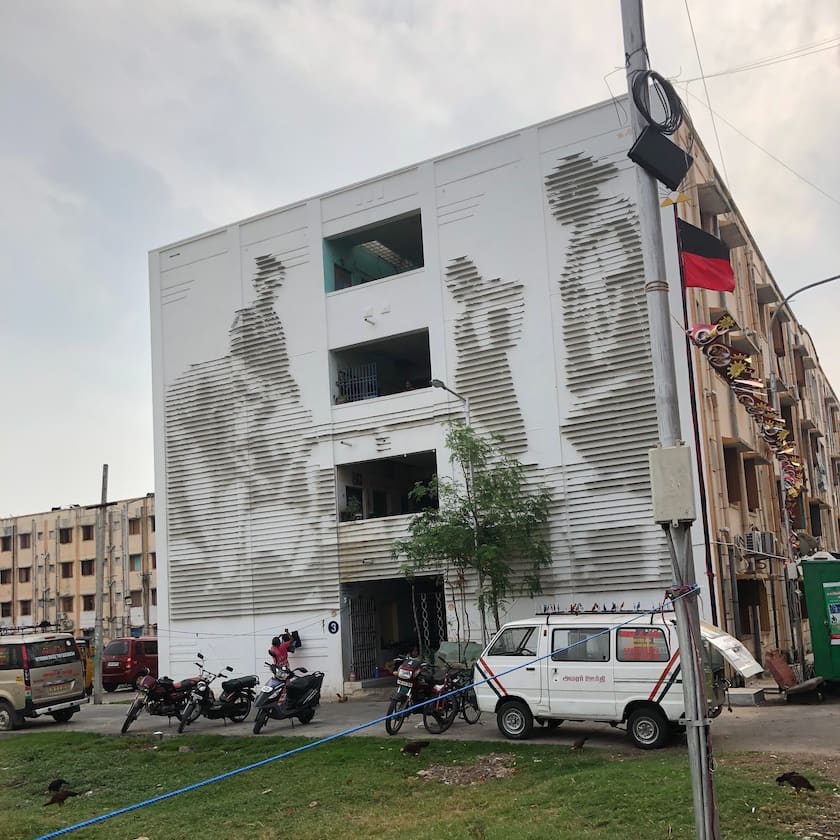



Osheen Siva's large mural shows a woman with green hair. She is sporting a set of turtle earrings and a large shell necklace. A saree in purple is worn over a blouse that has patterns of a fishing net. Protectors and Providers, the mural by Siva, a Chennai-based artist, and many other works of public art on the outer walls of homes in Kannagi Nagar on the outskirts of Tamil Nadu's capital contain elements of marine life. It is as if every person who has painted here is searching for a way to connect the art on these walls with the life inside. It is true too.
The lives of Kannagi Nagar residents are full of stories of survival and struggle. Most of its residents are survivors of the devastating tsunami that wreaked havoc in the port city on the coast of the Bay of Bengal nearly two decades ago. More than 8,000 people lost their lives on December 26, 2004 when giant waves wiped out whole villages on the east coast of Tamil Nadu. The state government rehabilitated tens of thousands of people whose homes were destroyed by the tsunami in Kannagi Nagar, considered one of the largest resettlements in Asia.
Located about 20 km from the city centre, Kannagi Nagar is a sea of small housing quarters (about 24,000 units) for 100,000 people built over an area of 100 acres. Formerly members of the fishing community who lived in the coastal areas of Chennai, Kannagi Nagar residents are today connected to the sea only by their memories. Separated from their traditional fishing jobs, the tsunami survivors here were forced to do odd jobs as daily workers, driving many into alcohol addiction and crime. A settlement that was built to give them a new life was becoming a colony of poverty and despair. Until art came to Kannagi Nagar.
"Kannagi Nagar was earlier in the news for unemployment and crime. Today it is an important place in Chennai's culture bringing film crews and visitors. Art has transformed the place," says M Nila, a transgender woman activist and member of Tamil Nadu Transgender Welfare Board. "Street art has definitely helped Kannagi Nagar giving its people hope for a better future," she adds about art empowering residents of the resettlement.
Murals painted by artists from India and abroad are not only returning fragments of links with the sea to the former fishing community, they are also helping heal the wounds inflicted by the tsunami. Between 2020 when the first frescoes appeared in Kannagi Nagar and now, more than 40,000 square feet of wall area have been painted in public art transforming the resettlement into a city of murals. Institutions like St+art India Foundation, a contemporary urban art initiative that brought street art to Kannagi Nagar for the first time, prefer the name, art district.
"There was nothing left for us after the tsunami. The government constructed houses here and allotted them to us," says Rajendran (uses only his first name), a resident of Kannagi Nagar who lived in the fisher community-dominated DD Nagar village near the famous Marina beach in Chennai before 2004. "I was 25 years old then and became addicted to alcohol. I have overcome it after receiving help," he says standing near a mural filled with marine life. "The artists who draw these works are friendly," he adds. Kalavathy (uses only first name), an assistant engineer responsible for buildings, roads and sanitation in the arts district, believes the wall paintings have significance in the lives of its residents. "The paintings are all saying something and giving the right messages to the people," she says. "The art has also made damaged walls look beautiful."
Located on the Old Mahabalipuram Road known before for its proximity to the 7th century rock monuments in Mahabalipuram and now for the sprawling Information Technology park, Kannagi Nagar is no stranger to the arts. The resettlment's name is borrowed from the ancient Tamil epic, Silappatikaram. Kannagi, the central character in the epic, is a fearless woman who always fights for the vulnerable and against injustice. Kannagi Nagar also lies in the monument-rich Kancheepuram district.
Emerging from a punishing pandemic, the arts district has begun to welcome artists back to its bylanes brimming with life. One of the new murals being painted pays tributes to the resilience of the tsunami survivors. Titled Fish Out of Water, the mural is a collaboration between Mumbai-born Aashti Miller and German graphic novelist Greta von Richthofen. The two artists painted the first part of their mural in Delhi's Lodhi arts district before starting on the second part in Kannagi Nagar. "Our work is about displacement, the sense of a new home for the fishing community who moved here after losing everything in the tsunami," says Miller, an architect and illustrator.
 A resettlement for the 2004 tsunami survivors on the outskirts of Chennai, Kannagi Nagar is considered Tamil Nadu's first arts district with many murals and frescoes on its walls.
A resettlement for the 2004 tsunami survivors on the outskirts of Chennai, Kannagi Nagar is considered Tamil Nadu's first arts district with many murals and frescoes on its walls.Chifumi, a Strasbourg-born French street artist now living in Phnom Penh, Cambodia, is painting a new mural inspired by colours of peacock and mudras in Kannagi Nagar. "The work is about opening the inner goodness in us," says Chifumi. "Public art is a pretext to meet new people. The important thing is connecting with communities," he adds. "Here the people are always smiling. And the children have a lot of energy."
The arrival of art in the resettlement has affected various aspects of life such as health, childcare, education and disability. Many NGOs have followed the artists into Kannagi Nagar conducting workshops in painting and photography for children and the differently abled. One such is the Chennai-based Kia Rassi, a not-for-profit organisation promoting art education among the differently abled. After Osheen Siva completed her mural here, Kia Rassi, Tamil for 'lucky hand', gave colouring books to differently-abled children based on the artwork. "After they finished colouring their books we took the children to the mural site to show them the art they had recreated themselves," says Divya Rao, the founder-director of Kia Rassi.
Iyyanar (uses only first name) is a traditional martial arts practitioner who conducts classes for children in Kannagi Nagar. Silambam, an ancient Tamil martial arts style using stick, rope, sword and fire that he teaches, has taken the settllement's children to national sports tournaments across the country. "Silambam helps the body and mind through movement," says Iyyanar about the benefits of martial arts. The children here are also learning photography, thanks to the initiatives of the Chennai Photo Biennale. Urban Design Collective, a collaborative platform for architects and planners for creating liveable cities, has engaged residents here in a postcard project to gather personal stories. The postcards were then mailed to addresses around the city to forge connections.
While organisations like Kia Rassi and Urban Design Collective have formed a lasting association with Kannagi Nagar, the residents of the resettlement have a long way to go. Many more such initiatives are needed at the public and private levels to create jobs and livelihoods for a population forced to adapt to a new environment by a brutal natural calamity. Art has certainly made a beginning for a better future for the people of Kannagi Nagar.
 Street artist Daku's visual imagery on empowerment of women in the resettlement.
Street artist Daku's visual imagery on empowerment of women in the resettlement. Discover the latest Business News, Sensex, and Nifty updates. Obtain Personal Finance insights, tax queries, and expert opinions on Moneycontrol or download the Moneycontrol App to stay updated!
Find the best of Al News in one place, specially curated for you every weekend.
Stay on top of the latest tech trends and biggest startup news.